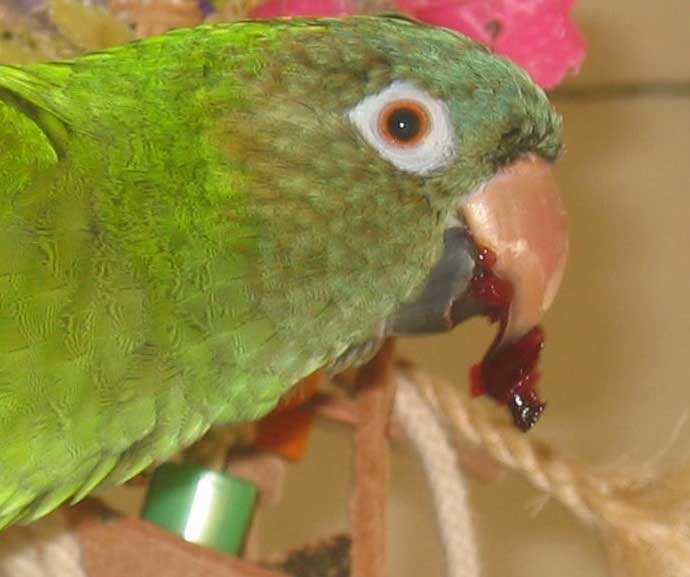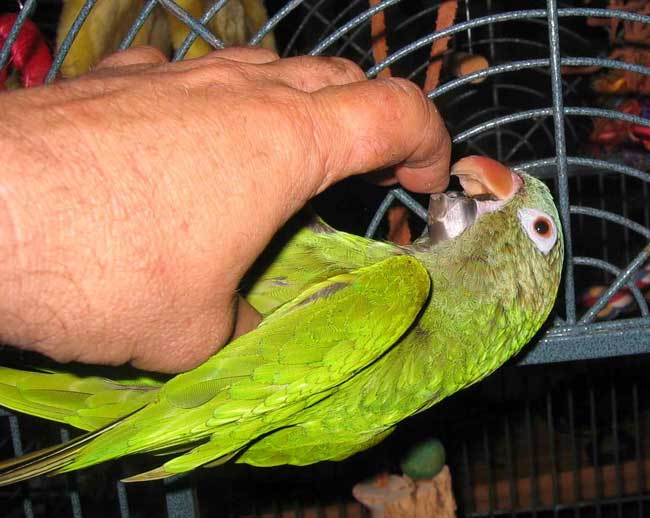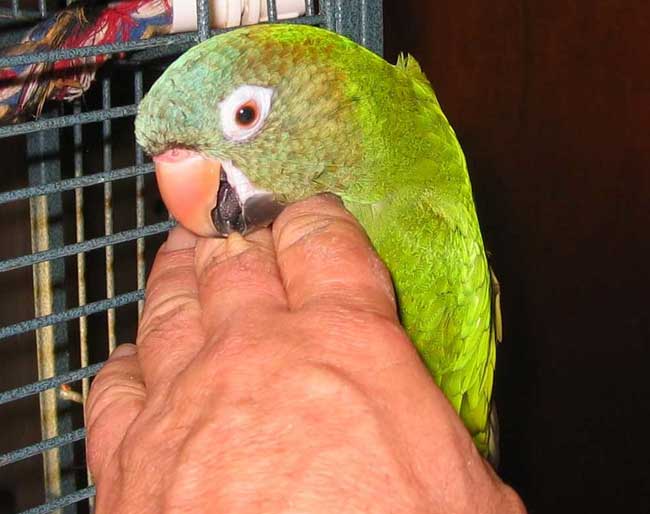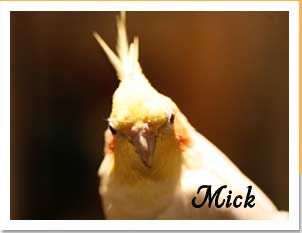Beak Language — Understanding Bites
By Jonathan Harris
All parrots bite — even, as Mira Tweti says, the hands that feed them. Sharp beaks and strong jaws can make these painful, sometimes bloody, experiences for their human companions, especially when they are unexpected. Humans used to the mild, rare, and easily controlled bites of dogs and cats often misinterpret the frequency of parrot bites as hostility or aggression. We may write them off to parrots being "wild" animals and restrict physical contact accordingly. Or if we want contact, we may label biting a "problem behavior" and try to extinguish it. Yes, parrots are wild, meaning we must try to understand and approach them on their terms, more than is necessary with our long-domesticated companions, who do a lot of that work for us. Certainly we should try to avoid and correct biting that is excessive or associated with trauma. But to interpret every nip as hostile both undermines our self-confidence as caregivers and distorts our perception of birds' moods and intentions. Even if we see ourselves as ultimately responsible, it imposes a false, "good-bad" dichotomy on their behavior, making each little feathered Skywalker the vessel for an inner Sith waiting to be pushed over to the Dark Side.
 NOT Darth Beaky
NOT Darth Beaky
Honest, it's nothing personal; it's Parrot.
How do they bite thee? In more ways than thou canst name. Parrots chronically chew their cages and toys simply to keep their beaks sharp and to discharge nervous tension. With flockmates, they use a whole beaky lexicon covering a wide range of subjects. Many bites are not hostile, aggressive, or defensive at all. Some are affectionate, while others simply convey or gather information. Biting and beaking likely represent a "third stream" of communication among parrots, a distinct and evolved medium as rich, varied, and subtle as their vocalizations and body language. If that is the case, it is neither possible nor desirable to suppress biting, since doing so would stifle an important natural channel of communication and self-expression.
To see why biting is so important, consider that parrots, like other birds, stand upright on two legs (one of several defining features we share). But having wings instead of arms and hands, they use their beaks and tongues to do many of the same things for which we use hands and fingers. Most parrots already use one foot to hold objects, so their beak and tongue become their other hand, allowing greater manipulation and deeper exploration. The beak in fact is probably the more important "hand." It has a much stronger grip than the fingers/toes as well as fine coordination and control.
Much as our hands and fingers serve us, the beak-tongue complex also takes in a great deal of sensory information for the bird. Both beak and tongue have many nerve endings, making them important tactile instruments. They are the bird's most direct and intimate way of knowing its world, probably one reason parrots spend so much time running their beaks and tongues all over cages, toys, and whatever else they encounter — including their human companions — and why they sometimes bite the fingers on which they are asked to step up: "Just testing! Gotta make sure this finger/perch is solid and you're not going to jerk it away."
Also like our expressive hands, the parrot's beak both sends and receives information. An organ with such tactile sensitivity and fine motor control offers an ideal medium for close-range communication. It must be important in wild flocks, where birds perch together, chattering, preening, squabbling and playing. In those intimate settings, bites may be gestures of affection and trust; they may be playful, taunting, warning, or disciplinary; they may represent irritation, anger, fear, or other emotions. And it is likely they express a similar range of feelings when directed toward human flockmates. A bite may mean "Leave me alone," "Stay out of my personal space," or "Get out of my way!" It may be part of allopreening and mean "I like you," "You are mine," or "Let's play." It may be part of play: "Ha! Gotcha now!!" It may mean "Ow! You snagged a pinfeather! Watch it, buddy!" It may mean, "Hey, I'm talking to you! Pay attention to me!" or "Um, ... you were just giving me a head rub a second ago, remember? Hey! HELLO!!??” It may mean "No! I don't want this (food you're offering)." It may be an urgent "Help! Get away from this danger!" or an outraged "You jerk! How dare you!?" And that doesn't begin to exhaust the possibilities. Many of these bites have distinct qualities in terms of target, strength, duration and/or repetition. Often they are associated with particular body language, vocalizations, or other contextual clues, all of which taken together say a lot about the parrot’s emotional state and intentions.
 Preening, play, and pain
Preening, play, and pain
A constant potential source of misunderstanding between birds and humans is our deplorable lack of feathers. When birds play or even fight with one another, they rarely break the skin; their beaks aren't trying to poke or slash so much as to grab each other's feathers (or beaks, in beak dueling). There are exceptions — fights resulting in serious injuries to face, foot, or beak — but among birds of the same species and/or size, these are mercifully rare. When birds bite and grab feathers, the bitten party sometimes squawks, but it can be hard to tell whether this is out of pain, fear, or outrage. Sometimes I lower my head and let Paco grab my hair; he will bite, tear, and tug on it excitedly, but my experience is quite different than being bitten when we hand-beak wrestle. So it is not surprising a light nip intended to communicate "hey, pet me" can be mis-read as "leave me alone." It always is necessary to interpret bites in the context of the bird's total behavior, vocalizations, and body language at the time they occur.
 Sharp beaks and strong jaws sometimes blur the continuum
Sharp beaks and strong jaws sometimes blur the continuum
We also should keep in mind that different species or groups of species have distinct and characteristic bites or ways of biting. Many cockatoos and cockatiels are beak pounders and will peck their humans for attention. Tiels also have their famous “snit-fits,” rapid-fire pecking-nipping across a surface, especially the hands on which they’re perched. Macaws are notorious for thrusting their open beaks at companions as a playful threat. Some parrots, including macaws and Aratinga conures tend to grab a hand or finger, then steadily increase pressure until its owner pulls away. Others (I think of some amazons) seem to have less subtlety or fewer bite settings: basically it’s either "on" or "off." I jokingly refer to these as "analog" and "digital" biters.
Some of these ideas are laid out in an old video of our Paco demonstrating various types of bites. At the beginning, I am preening his pinfeathers, and when I snag one incorrectly, he snarls and nips a gentle warning. Later, he beak thrusts and wrestles playfully. Still later, he asks for a nut, and when I offer him a pellet instead, he nips much harder and with obvious annoyance.
http://www.youtube.com/watch?v=9nvr8H8cNK4
We have only begun to understand parrots’ richly expressive body language and vocalizations, but our knowledge of this third channel of avian communication is practically nil. It is an area where ordinary people who observe their birds carefully can make real contributions to both scientific understanding and better bird care. Knowing our birds’ "beak language" is an essential part of improving and deepening our relations with these complex emotional and intelligent beings.
(I want to thank Maria Couragee for her insightful comments about the importance of feathers, or their absence, in how bites are meant by birds and interpreted by humans. She deserves most of the credit for that paragraph, above.)

